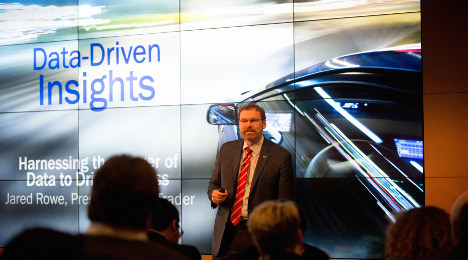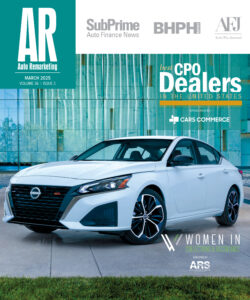AutoTrader’s Rowe: 2 Reasons Leasing Should be Higher

AutoTrader.com president Jared Rowe during the Haystak Digital Summit at Google on Wednesday. Photo credit: Haystak Digital Marketing.
Here is something you don’t hear every day: leasing is actually lower than it should be.
AutoTrader.com president Jared Rowe said this during an event Wednesday at Google headquarters — and the two reasons behind his assertion both have used-car implications.
First, he said, the industry’s remarketing structure is stronger than it has been in prior years, and from a negative equity perspective, many consumers are better off in a 2- or 3-year lease than they would be in a 5- or 6-year buying cycle.
Rowe was speaking at the 2015 Digital Summit event Wednesday, an event hosted by Haystak Digital Marketing at Google’s sprawling Mountain View, Calif., campus.
He was joined throughout the day by several leaders in both the digital and automotive space, including Cox Automotive president Sandy Schwartz and Haystak Digital Marketing founder Duncan Scarry
When asked by Auto Remarketing to elaborate during a Q&A about which part of the remarketing infrastructure has improved, Rowe said that automakers now have processes in maintain value and maximize value as vehicles come back into the remarketing cycle.
He also pointed out that some automakers who perhaps weren’t as strong at the certified pre-owned slice — a good protector of residuals on the off-lease front — back when the last lease return flood happened have learned lessons from years ago.
During a press conference at January’s 2015 NADA Convention & Expo in San Francisco, Experian Automotive presented its data indicating that leasing’s penetration of all new-car financing was 29.59 percent in the October/November time frame. As a percentage of all new-car sales, it was 24.82 percent.
Both figures represent the consistent and continued upward movement the leasing market has experienced over the past handful of years.
In fact, NADA Used Car Guide says in its latest Perspective report that leasing represented about a quarter of all new-car sales last year, versus 23.6 percent in 2013. The record high, NADA says, happened in 1997, when leasing commanded a 27.6-percent share of all new-car sales.
“We estimate that personal lease volume improved by approximately 9 percent to 3.14 million units in 2014 (commercial leases added another 500,000-plus units), which is the highest figure recorded since 1999’s record high of 3.3 million units,” NADA analysts said in the report.
“Given the growing appetite for leasing, it’s a safe bet that the number of personal leases booked in 2015 will surpass this figure by landing somewhere in the 3.3 to 3.4 million range,” they added.
When asked how healthy she believes this kind of high lease penetration to be, Experian senior director of automotive finance Melinda Zabritski said it’s a matter of consumer education and understanding this financial product.
“Well, the industry certainly enjoys it,” she told Auto Remarketing at the NADA conference, referring to lease penetration rate. “Leasing is just such an interesting product. As long as it’s well understood and there is consumer education around it, I think it has a lot of positives.
“You see those lower monthly payments (on the consumer side) and you’ve got — from the OEM and brand standpoint — the increased loyalty,” she added.
Additionally, Zabritski said, with the increase in longer-term loans (which results in those consumers staying out of the market longer), the boost in leasing and its quick turnaround of drivers re-entering the market helps balance that out.
But is there room for growth? Better yet, is current leasing penetration even sustainable?
“It’s kind of the $10,000 question right now. Everyone’s asking about that,” Zabritski said. “‘Where do you see it going? Do you expect it to hit 30 percent? Will it hit 30 (percent) next year?’
“It’s not going to hit 30 next year; that’s quite a big jump,” Zabritski added. “I don’t know what the magic number is for that. There are so many factors that come into play. You obviously have the balances within the portfolio, the push for the off-lease with the new purchase and moving metal.
“There are so many factors and analytics that go into trying to figure out, at least brand-by-brand, what that right number is,” she said. “I would hesitate to guess what that would be, industry-wide, because it’s obviously different across the manufacturers.”

 View The Latest Edition
View The Latest Edition

